SanDisk Extreme II Review (480GB, 240GB, 120GB)
by Anand Lal Shimpi on June 3, 2013 7:19 PM ESTAnandTech Storage Bench 2011 - Light Workload
Our new light workload actually has more write operations than read operations. The split is as follows: 372,630 reads and 459,709 writes. The relatively close read/write ratio does better mimic a typical light workload (although even lighter workloads would be far more read centric).
The I/O breakdown is similar to the heavy workload at small IOs, however you'll notice that there are far fewer large IO transfers:
| AnandTech Storage Bench 2011 - Light Workload IO Breakdown | ||||
| IO Size | % of Total | |||
| 4KB | 27% | |||
| 16KB | 8% | |||
| 32KB | 6% | |||
| 64KB | 5% | |||
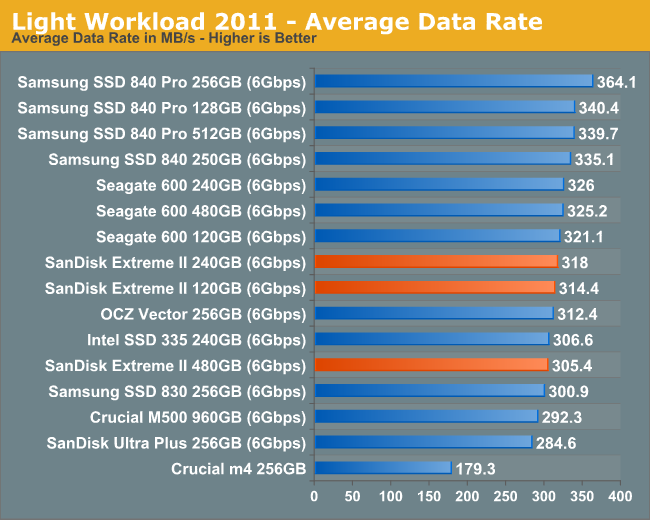
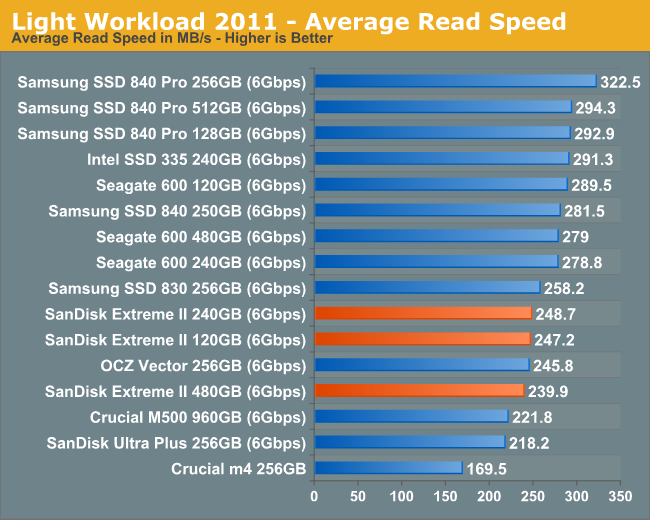
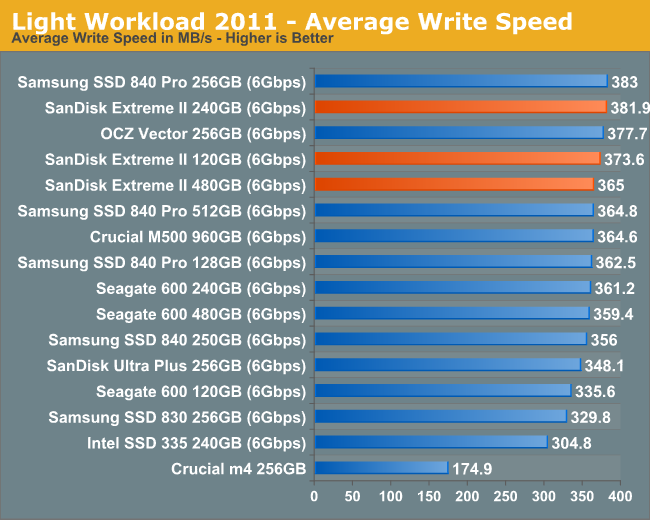
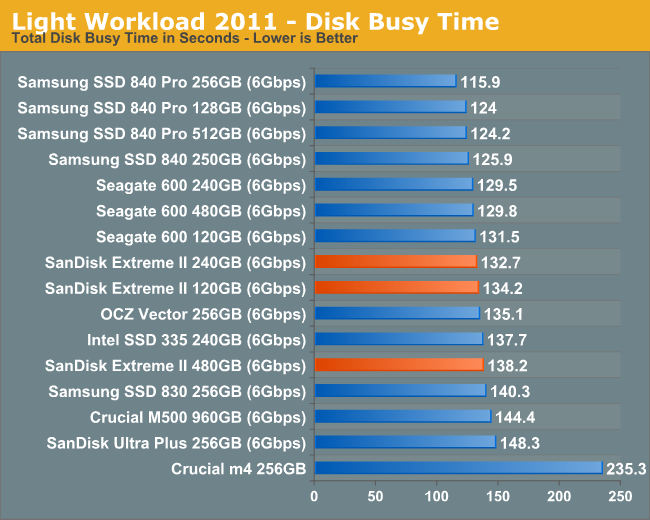
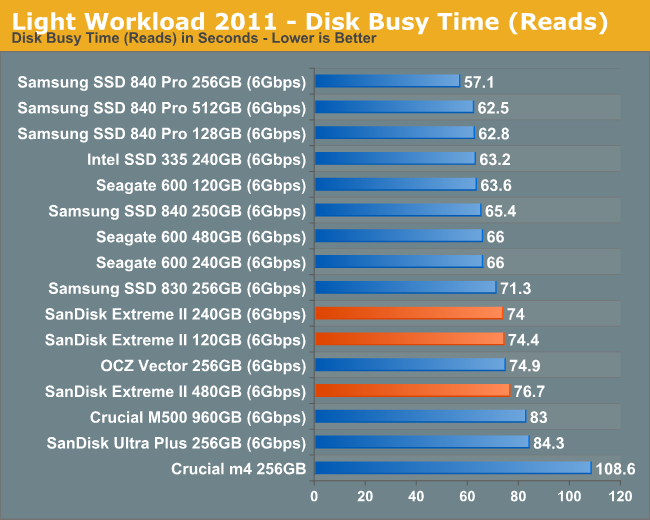
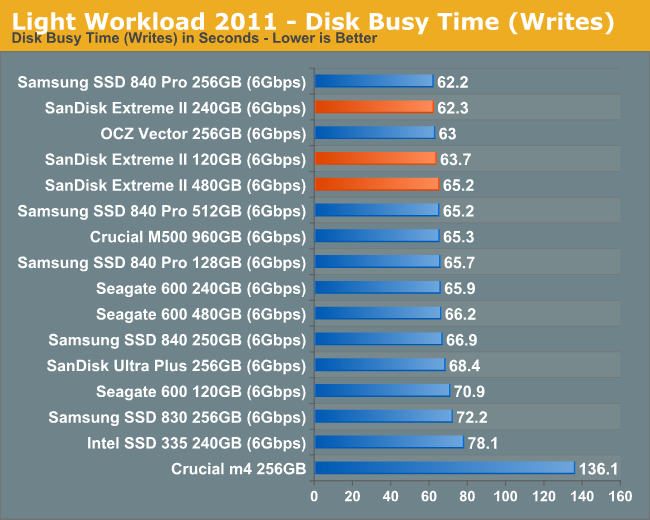










51 Comments
View All Comments
klmccaughey - Wednesday, June 5, 2013 - link
Hey, as one of these here "Coders" I can tell you my bread and butter is a ratio of 10:1 on thinking to coding ;) I suspect most programmers are similar.tipoo - Monday, June 3, 2013 - link
But in a sense Tukano is right, the SATA 3 standard can already be saturated by the fastest SSDs, so the connections between components are indeed the bottleneck. Most SSDs are still getting there, but the standard was saturated by the best almost as soon as it became widespread. They need a much bigger hop next time to leave some headroom.A5 - Monday, June 3, 2013 - link
The first round of SATA Express will give 16 Gbps for standard drives and up to 32 Gbps for mPCIe-style cards (used to be known as NGFF). I think we'll see a cool round of enthusiast drives once NGFF is finalized.althaz - Tuesday, June 4, 2013 - link
Storage is almost always the bottleneck. Faster storage = faster data moving around your PC's various subsystems. It's always better. You are certainly not likely to actually notice the incremental improvements from drive to the next, but it's important that these improvements are made, because you sure as hell WILL notice upgrading from something 5-6 generations different.What causes your PC to boot in 30 seconds is a combination of a lot of things, but seeing as mine boots in much closer to 5 seconds, I suspect you must be running a Windows 7 without a really fast SSD (I'm running 8 with an Intel 240Gb 520 series drive).
sna1970 - Tuesday, June 4, 2013 - link
not really.Storage is never a bottle neck . if you have enough memory , they will load once to the memory and thats it.
you need to eliminate the need to read the same data again thats all.
try to max your memory to 32G or 64 G , and make a 24G Ramdisk and install the application you want there. you will have instant running programs. there is no real bottlenecks.
kevith - Wednesday, June 5, 2013 - link
"Closer to 5 seconds".... From what point do you start counting...?seapeople - Wednesday, June 5, 2013 - link
Probably after he logs in.compvter - Friday, July 19, 2013 - link
5 seconds would be very fast, i get to windows desktop in w8 in 11 seconds. Calculated from pressing the power button on my laptop and stopped when i get to real desktop (not metro). I have older samsung 830 and first generation i7 cpu and 16gb memory.ickibar1234 - Friday, December 20, 2013 - link
After getting an SSD with a SATA 3 computer, it's mostly likely driver initialization, timers and stuff like that that is the bottleneck during bootup.Occas - Tuesday, June 4, 2013 - link
Regarding PC Boot time, easily for me it was my motherboard post time.My old Asus took minimum 20 seconds to post! When I bought my new system I researched post times and ended up with an ASRock which posts in about 5 seconds. Boom, now I can barely sit down before I'm ready to log in. :)